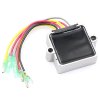UKGlenn
Member
The winter months mean lots of time surfing the net and thinking about what i want to do with my boat this year.
So far on the list is
Sound Deaden the engine area.
Install Smart Tabs or extend the ride plate.
Install a second battery for the stereo.
And maybe give the hull a coat of Hydrophilic coating!
Has anyone any experience of this? Has anyone noticed any improvements?
I might try some anyway its not like it costs much and if it does indeed save fuel as much as it says it does i'd be quids in over the summer.
So far on the list is
Sound Deaden the engine area.
Install Smart Tabs or extend the ride plate.
Install a second battery for the stereo.
And maybe give the hull a coat of Hydrophilic coating!
Has anyone any experience of this? Has anyone noticed any improvements?
I might try some anyway its not like it costs much and if it does indeed save fuel as much as it says it does i'd be quids in over the summer.









